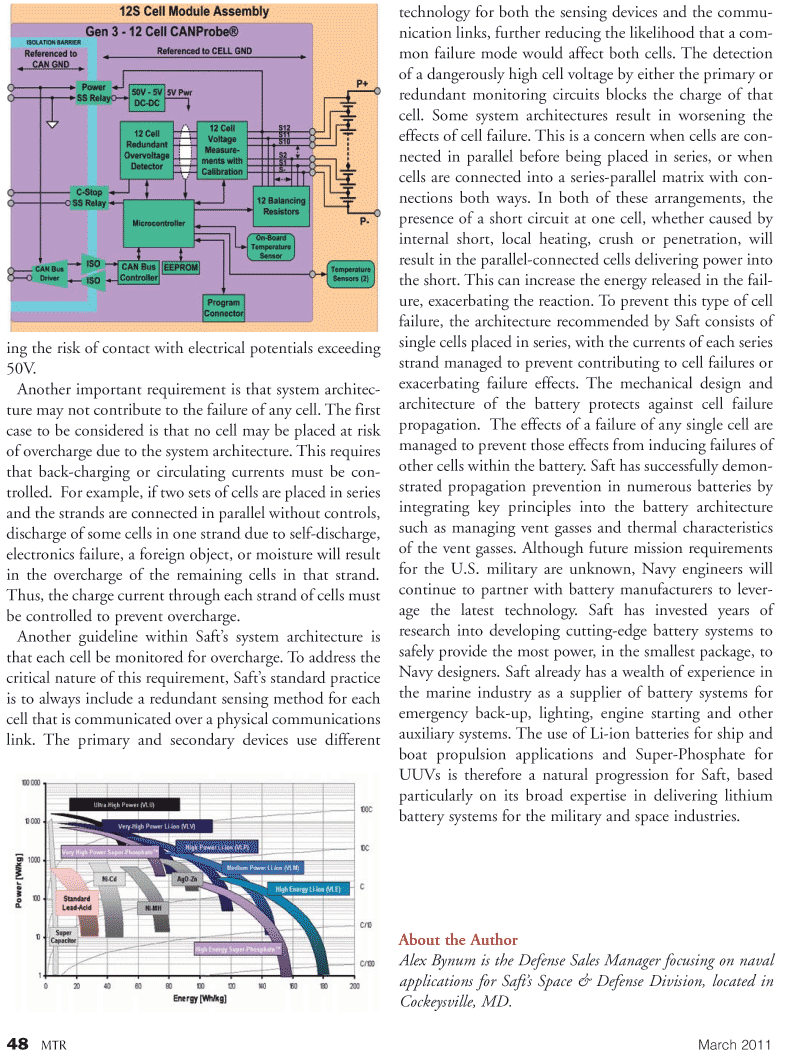
Page 48: of Marine Technology Magazine (March 2011)
Subsea Vehicles: AUV, ROV, UUV Annual
Read this page in Pdf, Flash or Html5 edition of March 2011 Marine Technology Magazine
48 MTR March 2011 ing the risk of contact with electrical potentials exceeding 50V.
Another important requirement is that system architec- ture may not contribute to the failure of any cell. The first case to be considered is that no cell may be placed at risk of overcharge due to the system architecture. This requires that back-charging or circulating currents must be con- trolled. For example, if two sets of cells are placed in series and the strands are connected in parallel without controls, discharge of some cells in one strand due to self-discharge, electronics failure, a foreign object, or moisture will result in the overcharge of the remaining cells in that strand.
Thus, the charge current through each strand of cells must be controlled to prevent overcharge.
Another guideline within Saft’s system architecture is that each cell be monitored for overcharge. To address the critical nature of this requirement, Saft’s standard practice is to always include a redundant sensing method for each cell that is communicated over a physical communications link. The primary and secondary devices use different technology for both the sensing devices and the commu- nication links, further reducing the likelihood that a com- mon failure mode would affect both cells. The detection of a dangerously high cell voltage by either the primary or redundant monitoring circuits blocks the charge of that cell. Some system architectures result in worsening the effects of cell failure. This is a concern when cells are con- nected in parallel before being placed in series, or when cells are connected into a series-parallel matrix with con- nections both ways. In both of these arrangements, the presence of a short circuit at one cell, whether caused by internal short, local heating, crush or penetration, will result in the parallel-connected cells delivering power into the short. This can increase the energy released in the fail- ure, exacerbating the reaction. To prevent this type of cell failure, the architecture recommended by Saft consists of single cells placed in series, with the currents of each series strand managed to prevent contributing to cell failures or exacerbating failure effects. The mechanical design and architecture of the battery protects against cell failure propagation. The effects of a failure of any single cell are managed to prevent those effects from inducing failures of other cells within the battery. Saft has successfully demon- strated propagation prevention in numerous batteries by integrating key principles into the battery architecture such as managing vent gasses and thermal characteristics of the vent gasses. Although future mission requirements for the U.S. military are unknown, Navy engineers will continue to partner with battery manufacturers to lever- age the latest technology. Saft has invested years of research into developing cutting-edge battery systems to safely provide the most power, in the smallest package, to
Navy designers. Saft already has a wealth of experience in the marine industry as a supplier of battery systems for emergency back-up, lighting, engine starting and other auxiliary systems. The use of Li-ion batteries for ship and boat propulsion applications and Super-Phosphate for
UUVs is therefore a natural progression for Saft, based particularly on its broad expertise in delivering lithium battery systems for the military and space industries.
About the Author
Alex Bynum is the Defense Sales Manager focusing on naval applications for Saft’s Space & Defense Division, located in
Cockeysville, MD.

 47
47

 49
49
